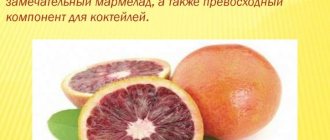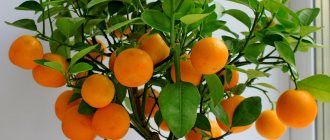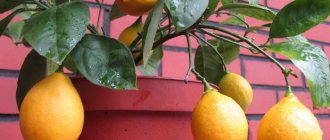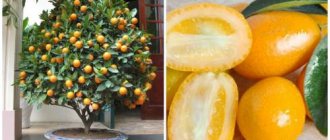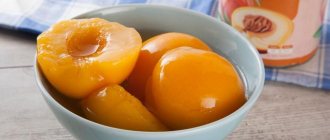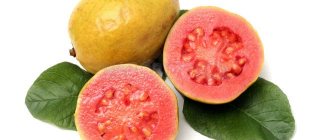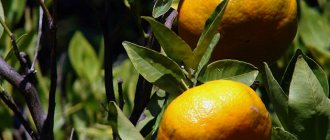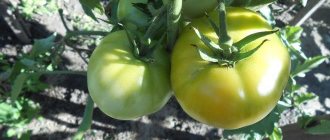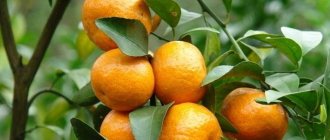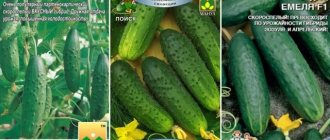Lemon is a tropical plant that, in indoor conditions and in inept hands, will get sick, drop leaves, or, conversely, become fat and refuse to bloom. The tasks of the home gardener: understand your green pet, create favorable conditions for it and get a harvest.
- 2 Popular and unusual varieties of lemons
- 3 Planting and replanting indoor lemon
3.1 Video: first transshipment of lemon seedlings
- 4.1 Video: about the difficulties of growing lemon at home
- 5.1 Video: caring for citrus fruits
- 6.1 Video: shaping and pruning citrus fruits
- 7.1 Video: Meyer lemon cuttings
- 8.1 Video: grafting into the cleft, behind the bark and bud
- 9.1 Video: treating lemon for scale insects, an old recipe
Lemon in nature and indoor conditions
The homeland of lemon is China, India and tropical islands in the Pacific Ocean. The plant was introduced into cultivation in the 12th century by residents of South and Southeast Asia. From there, lemon spread to the Middle East, Europe and even Africa. In Russia, on the Black Sea coast of the Caucasus, lemon plantings occupied 8 hectares of land in the 1970s. Today, these areas have decreased, but interest in potted culture, on the contrary, is growing.
The center of distribution of indoor lemons in our country is the city of Pavlovo, Nizhny Novgorod region. Here, more than 150 years ago, Pavlovsk lemon was bred using the method of folk selection. At home, 10–30 fruits are obtained from one plant; cases have been recorded when an adult tree in a tub yielded up to 200 lemons. By the way, there are several nurseries operating in Pavlovo, engaged in the cultivation and sale of citrus fruits; parcels are sent to all regions of the Russian Federation.
Pavlovsk lemon is considered a classic for Russia; other varieties that are loved by flower growers have also been bred or imported. There are lemons that have only decorative value, but the fruits of most varieties can be eaten. They are not inferior in size and taste to their wild tropical counterparts, and often surpass them.
How many types of lemon are there?
Among other citrus fruits, lemon is represented by the largest number of species and varieties. According to morphological and genetic characteristics they are divided into 4 groups:
- Common lemon - combines plants with sour fruits, light yellow in color, oval in shape with narrowing at both ends, and a hard-to-remove rind. It bears fruit generously and is heat and drought resistant. Represented by the Eureka and Lisbon varieties. The variety Eureka was bred at the end of the twentieth century in California. These are trees with a loose spherical crown, weakly thorny shoots, medium-sized fruits with rough or slightly ribbed skin. Lemons belonging to the Lisbon variety are tall plants with a densely leafy oval crown formed from erect, strongly spiny shoots. They produce large fruits with a smooth, shiny skin. Cultivated in Southeast and Central Asia, Southern Europe, and the Caucasus.
- Sweet - includes varieties with juicy, slightly acidic and pleasant-tasting fruit pulp. Their skin color can be yellow, yellowish-green, light orange, and their shape can be round or elongated-round. They arose as a result of various citrus hybridizations. They are grown in the Mediterranean countries, Western Asia, and Western India.
- Rough - trees up to 3-4 m in height, with a round or conical crown, thick, weakly thorny shoots. The fruits are oval or pear-shaped with a wide nipple at the end, thick wrinkled, rough, sometimes bumpy or wrinkled skin. The pulp is grayish-yellow, moderately sour, has medium juiciness and contains a large number of seeds. Cultivated in South Asia and Latin America.
- Various - this group includes hybrids with sour and sweet fruits. These are interspecific combinations that combine the properties of 2 or more citrus plants. There are also double varieties that produce sour and sweet fruits on one tree.
Most types of lemon begin to bear fruit 3-4 years after planting, reaching maximum yield by 10 years.
Attention! Lemon loves bright, diffused light, high humidity, warmth, and good aeration of the root system.
Planting and replanting indoor lemon
No matter how attractive lemons with flowers and fruits are, when purchasing, give preference to young seedlings, up to two years old. They will adapt more quickly to the conditions of your apartment and will not experience as much stress as adult plants. Bring the plant into the house, place it in its designated place, and only after a week begin replanting.
Bring young plants into the house, they adapt more easily to new conditions
The new pot should be 2–3 cm wider than the container in which the seedling is already growing. You can buy soil special for citrus fruits or make it yourself from equal parts of leaf or turf soil, humus, or coarse sand. Lemons grow in ordinary soil with a neutral reaction; they do not like pronounced alkaline and acidic soil. Be sure to warm the soil mixture to 100 °C to destroy eggs of mites, aphids and other pests, as well as spores of pathogenic fungi. You don’t want your new baby to get sick from the very first days and start dropping leaves.
Place drainage at the bottom of the pot with a 2–3 cm layer of clay shards, expanded clay, and pebbles. Then add a layer of soil and transfer the lemon with a lump of earth into a new pot. Fill the gaps between the root ball and the walls of the pot with soil mixture. Replant this way:
- young plant (first 2–3 years of life) - every spring;
- those that have entered fruiting - once every 2-3 years.
An already mature, large tree growing in a bucket or tub is no longer handled, but the top layer of soil, about 5–7 cm, is removed and replaced with a new one.
Video: first transshipment of lemon seedlings
You cannot plant a small lemon straight into a bucket or large pot. In the best case, the plant will become fatty and will not bear fruit for a long time; in the worst case, the roots will rot. After all, a small root system cannot absorb all the moisture from a huge pot; it is in constant dampness, without a sufficient amount of oxygen. Experienced citrus growers grow meter-long trees in 1.5–2 liter pots.
Harm and contraindications of kumquat
When trying the fruit for the first time, eat a small piece and wait 2-3 hours. If there is no allergic reaction, try the whole fruit.
Citrus fruit contains a large amount of organic acids; kumquat is harmful for people with disorders of the gastrointestinal tract.
Contraindications for use:
- gastritis with high acidity;
- pancreatitis;
- kidney diseases;
- breast-feeding.
Important!
The peel contains essential oils, so people with allergies to citrus fruits are strictly prohibited from eating kumquats.
What conditions need to be created for lemon?
Optimal conditions for lemon: diffused sunlight, day length - 12 hours. These descriptions correspond to spring and autumn days. In summer, the lemon needs to be protected from the scorching rays of the sun, but at the same time you cannot move the pot from place to place or turn the other side towards the glass. So keep the plant year-round in an east, southeast, or southwest window and mark the side of the pot facing the light in case you need to clean the window or take the lemon into the shower.
No matter how much you would like to turn the pot to the glass with the other side, you don’t need to do this!
With the onset of warmth, citrus can be taken out to the balcony or into the garden, under the crown of a tree, for the whole summer. At the same time, wrap the pot with cloth or paper so that the roots are not affected by changes in night and day temperatures. Lemon does not like sudden changes. Watch the weather and move the tree indoors before the onset of cool days (below +18... +20 °C). Often citrus growers bring flowering and fruiting lemons from a cold street into the house and get disastrous results: the tree sheds both leaves and fruits that have not yet grown, and in some cases even dies.
Favorable temperature in summer is +18… +26 °C, in winter +10… +14 °C. Lemons also grow at constant room temperature, but without additional lighting they drop their leaves and their lifespan is greatly reduced. It is still better to arrange a period of rest for the winter. Find a cool place, for example, on an insulated balcony or protect the window on which the plant is standing from the room with a thick curtain, insulate the heating radiator, etc.
Video: about the difficulties of growing lemon at home
Dried and dried kumquat
In stores, on the shelves with dried fruits you can often see dried or dried kumquats. With the correct manufacturing process, you get healthy candied fruits that are an excellent substitute for sweets, marmalade and other high-calorie and harmful sweets.
How to choose a quality dried or dried product:
- The natural color of kumquat is green, yellow or orange;
- elastic consistency;
- externally, the fruits resemble dates with wrinkled skin without damage;
- the structure characteristic of citrus fruits with small dots on the entire surface is preserved;
- The aroma and taste are rich, with a slight sourness and the smell of orange.
High-quality dried or dried kumquat retains all the beneficial properties of fresh fruit. If candied fruits are prepared using sugar syrup, consider the calorie content of the product when following a diet.
On a note!
The price for natural candied kumquat fruits is 200-300 hryvnia per kilogram.
Dried and dried kumquat
Features of care
For watering a lemon, only settled water without chlorine at the same temperature in which it is located is suitable. To do this, it is enough to keep the watering can next to the pot. It is necessary to water as the soil surface dries: during flowering and fruiting, generously to wet the entire lump, during the dormant period - only slightly moistening and not allowing the soil to dry out.
Some citrus growers add a few drops of lemon juice to the irrigation water, but this is not at all necessary.
Spray the leaves of the tree with clean water every day. Even if you have a drought-resistant variety, do not neglect this procedure. In dry air and warmth, spider mites easily grow and multiply exponentially. It will be difficult to eradicate them. It is especially important not to skip spraying in winter when the central heating is on. Give the lemon a warm shower once a month.
Lemon loves water treatments
The regularity and composition of fertilizing depends on the conditions of detention:
- With a period of rest. During the growing season, water every 2 weeks with a solution of special fertilizer for citrus fruits or vermicompost. You can use an infusion of herbs or nettle alone. In late autumn and winter, microelements and phosphorus are needed. Wood ash works well: 1 tbsp. l. pour 1 liter of water at night, pour this infusion under the lemon in the morning. Feed this way once a month until the growing season begins.
- Without a dormant period with year-round flowering and fruiting, water every 2 weeks with complex fertilizers containing all the macro- and microelements the plants need. Use mixtures for citrus fruits, indoor and balcony plants. The most popular and reliable brand today is Fertika.
Lemon flowers are bisexual and pollinate themselves, but you can also help by arming yourself with a soft brush and working as a bee. Many varieties bloom very profusely, however, they form much fewer ovaries. This is normal, the tree bears as many fruits as it can bear. It happens that not only excess flowers fall off, but also the ovaries.
Use a soft brush to collect pollen and apply it to the stigma
Harvest according to the ripening time for your variety. The yellow color of the skin does not always mean complete ripeness, and the green color does not always mean immaturity. Some varieties drop ripe fruits themselves.
Video: caring for citrus fruits
Composition and calorie content of kumquat
Bright juicy fruits will appeal to all citrus lovers. The fruits are rich in fiber and water, have a rich taste and aroma.
100 grams of kumquat contains:
- water – 80 g;
- proteins – 2 g;
- fats – 1 g;
- carbohydrates – 10 g;
- fiber – 7 g;
- ash – 0.5 g.
The calorie content of kumquat is only 70 kcal per 100 grams of fresh fruit.
On a note!
The glycemic index of kumquat is 35 units.
Reproduction by cuttings, layering, seeds
The easiest way to propagate lemons is by cuttings. Each spring, as a result of pruning, you will have a lot of planting material. Moreover, you can get a new lemon in the first year of growing an existing one by cutting off its top when forming. The cuttings should have 3–5 leaves, they can be shortened by half or left entirely. If this is the top, then pinch the growing point.
Next, bury the cutting 2 cm into a moist substrate - sand or perlite. Cover with a plastic bag or upside down jar. After about a month, the new plant will begin to sprout young leaves. When the roots grow to 10 cm in length, transplant the small lemon into a pot. For rooting, take cups with transparent walls, then you can observe the development of the horse system. If you took a cutting from an already mature fruit-bearing tree, it may bloom in the year of planting. Be sure to remove all buds so that they do not draw precious juices onto themselves. A young plant needs to develop roots and a rich crown.
Video: Meyer lemon cuttings
However, cuttings do not always give a positive result; out of 10 branches, on average 4–5 take root. There is a more reliable, but less simple way - rooting by air layering:
- Select a branch that has one- or even two-year-old wood.
- Using a sharp knife, remove the bark from the branch in a 1-2 cm wide ring.
- Place a plastic bag or sleeve over the cut area.
- Pull it below the cut and tape it to the branch, fill the bag with a damp substrate (loose soil mixture, peat, moss), close the top edge tightly around the branch and also wrap it with tape.
- In the place of cutting, in humid conditions, callus is formed, and then roots, this will happen in about 1–2 months. The roots will begin to take moisture from the soil, so you will have to make a hole, close it with tape, and periodically water it through a syringe or syringe.
- When the branched roots are clearly visible through the transparent walls of the bag, the branch can be cut off and planted in a pot.
Rooting by air layering was successful, well-developed roots are visible through the film
Another way to propagate lemons is by seeds. But, according to numerous reviews, you have to wait a very long time for the harvest from seedlings - 5–7 years, and sometimes 15. This is impractical, although you can grow such a seedling to later use it as a rootstock.
Even a child can grow a lemon from a seed: bury it to a depth of 2–3 cm in any flower pot and water it. No stratification is needed. To be sure, sow a few seeds. Shoots will appear in 3–4 weeks.
Lemon "Buddha's Hand"
“Hand of Buddha” is a lemon that attracts attention with its unusual appearance of fruit. This is a small tree or shrub 1.2 - 3 m high. Branches with single axillary spines. The leaves are large, oval, oblong, dark green, dense. The fruits of this fruit are the longest among all citrus fruits. They reach a length of about 40 cm, a diameter of about 30 cm. They consist of a single peel 5 cm thick and contain a very small amount of pulp. The surface of the fruit is ribbed, rough, yellow or orange. The pulp is slightly juicy, sour or bitter, so the fruit is not suitable for food. It is used in the manufacture of confectionery and perfumery products.
The Buddha's Hand lemon looks like a hand with long, unusually curved fingers, which is how the variety got its name. Its aroma is similar to that of violets.
This citrus is heat- and light-loving, mainly grown in tropical and subtropical conditions. It begins bearing fruit at the 3rd year of life.
Lemon grafting methods
Any citrus tree older than 1 year in the active stage, that is, in spring and summer, when sap flow occurs, is suitable as a rootstock. You can graft buds or cuttings of different varieties and even tangerines, oranges and other plants from this family onto the skeletal branches of one lemon. Experts give a hint: hypermarkets often sell tangerines and lemons with twigs. If they are fresh, with green leaves, you can graft them onto a wildflower grown from a seed. The chances are slim, but they are there. As a result, you will receive a free cultivated plant.
Before grafting, cut the tree to a stump or leave the trunk and the base of the skeletal branches if you want to make several grafts: one for each branch. There are several ways to plant a lemon:
- Kidney.
Using a razor blade, cut off a piece of bark 2–3 cm long and 0.5–1 cm wide on the wild wood. You need to cut it without touching the wood. On a cultivated plant, select a branch 3–4 mm thick with old, roughened leaves and bark, take a cutting from it with the number of buds you need for grafting. Trim the leaves, leaving the petioles. Now, using a blade, cut off the bud with a piece of bark, the size and shape of which corresponds to the shred cut out on the game. Place the kidney at the vaccination site and wrap it tightly with a special vaccination tape, fum tape or a strip cut from a latex medical glove. Bud grafting: a scion consisting of bark, leaf petiole and a bud in the axil is applied to a cut of bark on the rootstock - Into the cleft Using a sharp knife, cut the trunk of the wildflower vertically from top to bottom strictly in the center to a depth of about 2 cm. Now cut the bottom of the cuttings of the cultivated plant in the shape of a wedge - a blade. Insert the cut side of the cutting into the wood split and wrap it up.
The bottom of the cutting of a cultivated lemon is cut with a wedge and inserted into the cleft in the wild
- For the bark. This is the most familiar method to us; we see such grafting on almost all fruit trees that we buy for our garden. Make a shallow vertical cut into the bark from the top edge of the rootstock stump downwards. Separate the bark from the trunk, as if pushing the flaps apart. Make an oblique cut at the bottom of the scion cutting, press it with this place to the cut on the wild wood, cover it with bark flaps and wrap it.
The bark is pushed back onto the rootstock, the cutting is pressed to this place with an oblique cut
Engraftment lasts 5–7 days. If the bud or cutting has not turned black or dried out during this time, then the grafting was a success. Cultured buds will bloom in about a month. Any wild shoots that appear must be removed.
Video: grafting into the cleft, behind the bark and bud
How to determine the variety of lemon
Many varieties with clearly expressed characteristics are easy to distinguish. It is easier to determine by the appearance of the fruit than to recognize the type of lemon by the leaves.
Should be considered:
- height and pattern of the tree crown;
- thickness and color of shoot bark;
- leaf size and shape;
- presence of thorns;
- peel thickness;
- structure, aroma and taste of the pulp.
Determining the variety of lemon by leaves is a rather complex analytical process, completely accessible only to specialists.
Pest and disease control
Literally all the pests that are capable of living indoors live on lemons: mealybugs, spider mites, aphids, scale insects, whiteflies, etc. In addition, indoor plants are affected by root rot, sooty fungus, anthracnose, homosis, and scab. It is easier to protect lemon from all these troubles than to cure it, so pay attention to prevention:
- Create favorable conditions for lemon without sudden changes in temperature, humidity, or light.
- Feed, water. The plant sharply loses its immunity and cannot resist diseases and pests if it lacks nutrition and moisture.
- Despite the love of lemons for moist air, do not flood the soil. Use pots with drainage holes.
- Once every 1–2 weeks, add Fitosoprin to the irrigation water, you can spray its solution on the leaves, dust the soil with wood ash, tobacco, mustard cake, add charcoal to the soil mixture for replanting.
- Wash the lemon leaves and stems every month with soapy water.
- During critical and difficult periods for lemons (after illness, transplantation, sudden changes in living conditions), spray the leaves with stimulants and vitamins: Epin, Energen, Novosil.
If trouble happens, use systemic insecticides to combat insect pests, acaricides for mites, and fungicides for diseases. Follow the instructions and start processing as early as possible. To prevent the situation from getting worse, once a week carefully examine the lemon leaves on both sides. Spray when you notice the first signs.
Many varieties of lemon bloom and bear fruit all year round; they cannot be treated with chemicals. You can only use folk remedies, but they are ineffective and labor-intensive, for example, wipe each leaf with alcohol, infusions of herbs, garlic, onion peels, etc. Repeat the procedure every week.
Video: treating lemon for scale insects, an old recipe
My green pets were attacked by aphids and spider mites. I know how difficult it is to get rid of such parasites, because the full cycle from hatching from an egg to sexual maturity at room temperature takes only 5-7 days. As soon as you destroy one generation and breathe easy, the next one immediately hatches and again pumps out the juices from the plants. Whatever I did: poisoned with Karbofos and Aktara, washed every leaf, collected diseased leaves, cut out entire branches, but even with my stubbornness, I just wanted to give up and throw the unfortunate plant in the trash. Therefore, it is better to prevent the development of parasites, destroy them at the very beginning, or take all possible measures to improve the health of your lemon.
How to eat kumquats
Unlike other citrus fruits, kumquat is eaten unpeeled:
- rinse the fruits thoroughly under running water;
- cut in half or into slices if desired;
- remove the seeds;
- Sprinkle with sugar to taste.
Our supermarkets sell sweet varieties of fruits. Fruit harvesting begins in October; citrus fruits are often picked slightly unripe; they ripen in 1-2 weeks during transportation and storage. We recommend buying the most delicious juicy ripe kumquats no earlier than November, like tangerines.
How is wild lemon poncirus used in households and folk medicine?
In official medicine there is no use for the fruits of the wild lemon poncirus, but traditional medicine uses the entire plant:
- Ripe fruits are used in cooking and perfumery.
- Stems, leaves, peel, seeds, and even roots in the East, where wild lemon grows in thickets, are used to produce essential oil.
- And even unripe fruits help: With stomach upsets Have diuretic properties Improve lactation for young mothers
- Dried wild lemon peels, folded in a small linen bag, will fill a room or closet with bed linen with a pleasant aroma.
Beneficial properties of wild lemon poncirus
Wild lemon is a very useful vitamin product. In addition to vitamins A, C, E, PP, poncirus contains the following B vitamins: B1, B2, B5, B6, B7. Wild lemon is also rich in:
- Potassium
- Gray
- Calcium
- Chlorine
- Phosphorus
- Magnesium
- Zinc
- Iron
- Fluorine
Rare microelements:
- Molybdenum
- Borom
- Copper
Wild lemon in cross section
Growing lemon from seed
A lemon tree with fruits is what gardeners strive for. To get fragrant fruits, you need to grow a lemon from a seed and carry out the correct grafting.
Planting seeds
Seeds are taken only from well-ripened lemons. Flat and ugly seeds are discarded, leaving only large ones. They need to be planted immediately so that they do not dry out, otherwise they may not germinate at all.
For planting, seeds are discarded, only the best and thickest are retained, empty ones are immediately thrown away.
Before planting, it is recommended to treat the seeds with a growth stimulator. To do this, you need to dilute the drug in accordance with the instructions, place the seeds in it, remove it and plant it in the prepared soil. You need to soak for 12 hours, the procedure is best done at night.
It is better to take purchased soil, and yogurt cups or plastic bottles. Be sure to place drainage at the bottom of the planting container: pebbles, shards from clay pots or expanded clay. Perlite can serve as good drainage; a layer of 1.5 cm can also be used. Vermiculite can also be used, but it cakes faster.
You need to plant the seeds as thick as possible, then from the resulting seedlings you can choose healthy and strong plants
You need to plant a lot of lemon seeds, because you shouldn’t hope that all of them will sprout. And from the seedlings that appear, it will be possible to choose strong and well-developing ones. Good growth will contribute to successful grafting in the future.
The soil should be loose and fertile. You can buy a mixture for citrus fruits in the store. You can prepare the soil yourself by taking leaf soil and humus in equal proportions and mixing it with peat and sand. The soil needs to be moistened and 1 seed should be planted in each cup, burying the seed 2 cm deep.
The success of germination depends on the air temperature in the room; it should not be lower than + 18 °C. To speed up germination, cups with seeds are placed in mini-greenhouses and sent to a warm, well-lit place.
Successful rooting - small plants begin to grow
After planting, you should not water the ground; you need to plant it in already moistened soil, otherwise they may suffocate and the ground will become covered with mold. Water only after the soil ball has completely dried out. After germination, little watering is required to prevent rotting of the root system.
Seedling care
Lemon tree seedlings
You should not wait for friendly shoots; sprouts appear at different times, although there are exceptions. The optimal period for germination is 2 weeks - 1 month. At first, young plants need to be kept in a mini-greenhouse, until real leaves develop on the plant.
Then you need to gradually accustom the lemons to room temperature. It is necessary to open the greenhouse often and ventilate it, but still close it at night. Watering should be done by spraying.
Young plants should be on a well-lit windowsill, out of direct sunlight. If the plantings are located on a southern windowsill, it is necessary to shade them from the sun’s rays at lunchtime or move them deeper into the room.
Rules for growing indoor trees
A lemon grown from a seed is grafted and is already bearing fruit.
It is almost impossible to create a citrus garden in your home without basic knowledge of agricultural technology for growing exotic plants. Therefore, it is necessary to become familiar with the optimal growing conditions: temperature, lighting, watering, fertilization, and soil selection.
Optimal temperature
Homemade lemon feels great at temperatures from + 10 °C to + 22 °C. Under natural growing conditions, lemons are accustomed to a subtropical climate, so you should not try to arrange tropical conditions with unbearable heat for your pet.
Moderate warmth will be enough for him. The temperature of winter and summer maintenance should be different. In winter – within + 10-14 °C. In summer, you can take the pot with the plant outside or onto the loggia.
Lighting
In summer, the tree can be taken out into the fresh air so that it receives enough light
Lemon is a light-loving crop, so it prefers bright but diffuse lighting. Direct rays can play a cruel joke and destroy a young plant; an adult, on the contrary, needs to bathe in direct sunlight.
If the plant grows on a windowsill, then it is better to place it on a window on the east side; if the window faces south, then the pot is placed near the window, but not on the windowsill.
Moderate watering
Lemon does not like stagnant water
During the period of active growth (May-September), moderate watering is required. In overly moist soil, the roots of the plant simply suffocate and begin to rot. Between waterings, the earthen ball should dry out completely. In winter, water rarely.
You can tell that the soil has begun to turn sour by smelling it. If you lean towards the pot, you can smell an unpleasant, sour smell. To prevent the earthen clod from souring, it is necessary to loosen the soil more often and ventilate the mini-greenhouse.
Spraying the plant
In addition to watering, the lemon tree needs to spray the foliage. It is better to humidify the air more often than to overuse watering. From time to time you need to wipe the foliage with a damp cloth, cleaning the pores of the leaf blades from dust and dirt.
Soil
In the store you can purchase ready-made soil for planting indoor lemons.
Lemons prefer neutral soil, the pH of which does not exceed 5.8-6.5. However, many gardeners prefer to grow lemons in soil prepared with their own hands.
Soil for growing lemons:
- 1 part turf soil
- 1 part leaf soil
- 0.5 parts humus
- 0.5 parts peat
You can add pieces of charcoal to the soil. Before planting, a layer of drainage is placed on the bottom of the pot and only then the plant is planted. Pieces of brick or river sand can serve as drainage.
Fertilizer application
Short description
During the entire growing season, the trees are fed 2 times by applying complex fertilizers for citrus plants. Starting in mid-autumn, all feeding is stopped and the plant goes into a dormant period.
Lemon transplant
Transplantation process
When transplanting seedlings into a larger pot, it is necessary to take into account the size of the root system. You should not give it a lot of space at once, as empty soil can quickly turn sour and destroy the plant. As they grow, they are transferred to a larger pot, without violating the integrity of the earthen coma. When replanting, the root collar should not be buried.
How to grow a real tangerine tree?
In its development, the tangerine tree will not be particularly whimsical. The main thing is to provide him with an abundance of sunlight, 12 hours a day all year round. Therefore, if you want to grow a naturally beautiful tree, you will need additional intense lighting on winter evenings. There will also be some professional secrets to help.
Choosing a tangerine variety
Now let's look a little at the varieties:
- Unshiu is a frost-resistant and very productive variety. Your tree will be low, with a spreading crown of flexible thin branches, and with corrugated leaves. This tangerine grows quickly and produces good fruit. And if you add artificial lighting, things will go even better.
- Shiva Mikan is a compact tangerine tree with large dark green foliage. Blooms and grows quickly.
- The honey variety is the rarest variety, with very sweet tangerines.
- And the Kovane-vasse mandarin is the tallest, suitable for home use. Just right for the garden!
Look what wonderful citrus trees grow when you choose the right variety:
Proper seed preparation
So, the first step is to get seeds for the future tangerine tree. Ripe fruits from the store are ideal for this purpose: take at least 10 of these seeds. The more, the better: you probably know that any planting material does not germinate 100%.
Second step: let the seeds hatch. To do this they need moisture. Wrap the seeds in damp gauze and leave it like that for several days. Gauze, in turn, will not allow moisture to quickly evaporate, and at the same time the bones will “breathe”.
Now let's prepare the soil. The easiest way is to buy it at a flower shop, it’s called “special for citrus fruits,” or roll up your sleeves and make a nutritious base yourself. Simply combine leafy turf soil with compost or rotted humus in equal parts. The only main thing is that there is no peat in your land.
Now you can plant the hatched seeds in this soil. But be patient: the first shoots will appear from 3 weeks to a whole month, because tangerine grows slowly and from time to time also stops its growth according to some biological laws unknown to us.
Abundance of moisture
The tangerine tree loves moisture, and in the summer it must be watered (but without flooding). In winter, you should reduce the amount of moisture, while making sure that the soil does not dry out. After all, future fruits need to be “filled,” as people say.
To compensate for the dryness of the home air, it is advisable to spray the tangerine leaves with clean boiled water (or filtered) every day.
Careful transplant
When your tangerine tree grows, move it to a larger pot. The ideal time is February-March. Such a plant should be replanted using the transshipment method in order to preserve the earthen ball as much as possible and not damage the delicate root system.
Viral diseases of lemon
There are 3 viral diseases:
- sheet mosaic
- citrus cancer
- tristeza
Sheet mosaic
The appearance of a viral disease is indicated by the presence of dark or light streaks and stains on the leaf blades, similar to a mosaic. The foliage loses its shape. The disease reduces the growth of the tree.
Lemon tree foliage affected by leaf mosaic
Effective treatments have not yet been invented, but the manifestation can be reduced by applying regular fertilizers and carefully caring for the plant.
If there is only one tree in the house, then you can still try to save it, but if there is a collection, then the virus-infected specimen must be destroyed so as not to infect others.
Lemon tree cancer
The appearance of the virus is indicated by underdeveloped fruits interspersed with brown color. Such stains are also present on the foliage. If the disease is left untreated, the leaves will fall off, the lemons will become ugly and the tree will eventually die.
Plant with cancer
It is impossible to cure cancer! You can prevent it from appearing! To do this, you need to spray the plants with a solution of liquid copper every year, in early spring.
Tristeza
A viral disease causes the leaves to fall off, the tree becomes “naked”, and the woody part dies. Ultimately, this leads to the death of the plant.
Lemons and hybrids \ C. Limon
Femminello is a group of varieties of Italian origin, high-yielding, excellent taste.
Lemon "Fimminello Comune"
C. limon "Femminello comune"
An ancient Italian variety that is very popular. Our family has been growing this lemon for about 18 years. One of the best in terms of fruit quality and yield. At the age of 4-5 years, up to 50 fruits can be collected from one tree (with good care). The size of the fruit is large, oval in shape, seeds are rare. The fruit nipple is rough, small, slightly flattened. The pulp is very juicy, tender, aromatic, the taste of the juice is sour and pleasant. The peel is smooth, slightly bumpy, medium thickness. The variety was brought to Sukhumi from Italy in 1928.
Lemon "Fimminello Comune" nucellar (Italy)
C. limon "Femminello comune nucellare"
An ancient Italian variety that is very popular. One of the best in terms of fruit quality and yield. At the age of 4-5 years, up to 50 fruits can be collected from one tree (with good care). The size of the fruit is large, oval in shape, seeds are rare. The fruit nipple is rough, small, slightly flattened. The pulp is very juicy, tender, aromatic, the taste of the juice is sour and pleasant. The peel is smooth, slightly bumpy, medium thickness. The “nucellar” clone (nucellare NL46-644) was obtained at the CRA Institute of Agriculture (CRA-Istituto Sperimentale), in the city of Acireale, in 1946.
Lemon "Femminello Adamo" C. limon "Femminello Adamo"
Variety from the Mascali region, Giarre, Italy. The tree is medium-sized, growing upward rather than spreading. Young shoots are green and purple, flowers are white to purple. This variety is resistant to malsecco with very good balanced productivity. The fruit is elliptical, medium size (120-130g) with a small spout. The skin is medium thick and bright yellow in color. The pulp is very sour (more than 6% acid) and has excellent taste. The fruits contain practically no seeds and ripen gradually from November to January.
Lemon "Femminello Zagara Bianca" C. limon "Femminello Zagara Bianca"
The variety comes from Italy, most likely a bud mutation from the cultivar "Femminello comune", known since ancient times and still widely grown in Sicily. The tree has a vigorous growth rate, the leaves are elliptical, slightly rounded at the end, and sometimes have thorns on the branches. The variety is very productive. It blooms with white flowers (as indicated by the words “zagara bianca” in the name). The fruits are medium in size (130 - 160 g) and have a lemon-like shape with a rounded base; the peel is yellow, smooth, and of medium thickness. The pulp is yellow, very juicy and sour, of excellent quality. There are usually 10 segments, with an average number of seeds. The fruits ripen from October to December and withstand transportation well. This is a real commercial Italian lemon variety.
Lemon "Femminello Incappucciato" C. limon "Femminello Incappucciato"
Origin unknown. A widely cultivated, cold-resistant, late-ripening variety. Productivity is average. The leaves have a tendency to “turn out” in the shape of a boat. From the Italian “incappucciato” can, with some stretch, be translated as “cap-like, hood-like.” Lemon "Femminello Carrubaro" C. limon "Femminello Carrubaro"
The Femminello Сarrubaro lemon arose as a result of a spontaneous mutation of the widespread Femminello Сomune variety. The word Carrubaro is the local Italian name for the plant Ceratonia siliqua L. or Carob, widespread in Sicily. This variety of lemon resembles this tree in that its flowers and fruits appear in clusters. And young shoots are purple in color (as are small ovaries). The fruits are small to large in size, marketable, elongated, and have a small “spout.” The pulp is bright yellow, sour, juicy, tender. There are practically no seeds, from 0-2 seeds per fruit. The peel is bright yellow, medium thickness, aromatic. Highly productive remontant variety!
Lemon "Femminello Santa Teresa"
C. limon "Femminello Santa Teresa"
The Italian variety "Santa Teresa" was found in Santa Teresa di Riva, Sicily, Italy (Santa Teresa di Riva) and selected from the Femminello group of lemons. Femminello is the most widely grown group of lemons in Italy. It is grown in Turkey, where it is distributed under the name “Italian”, as well as in Argentina. The fruits are of high quality, long-lasting, and the yield is high. Fruit weight up to 90 g. The peel is slightly rough, aromatic, rich in essential oils, greenish-yellow, 4-5 mm thick, dense. Valued for the high content of essential oils in the peel. An excellent variety for making Limoncello.
Lemon "Lemox"
S. limon “Lemox” \ Limone Femminello x Pera del commendatore(2x) x limone doppio Lentini (4x)
Lemox is a triploid hybrid ('Ferminello' lemon x 'Pera del Commendatore') x 'Doppio Lentini' lemon. "Lemox" is not a true lemon, but its fruits have very good taste. The advantage of this variety is the early ripening of fruits, as well as high resistance to diseases and malsecco. Under natural conditions, the fruits begin to ripen in September. Citrus has an average growth rate, a spreading crown, and has many medium-sized thorns. The fruit is elliptical in shape, the flesh is fine-grained, without seeds. The peel is yellow when fully ripe. Ripening begins in the first ten days of October, when most fruits reach an average weight of 120g. "Lemox" can be considered the first hybrid with fruit characteristics very similar to those of a real lemon.
Lemon "Novogruzinsky"
(Novo-Athos)
The “Novogruzinsky” variety is unpretentious and productive. The flowers are large, 5 petal. The shape of the fruit is elongated-oval, the base is in the form of a short neck. There are few seeds in the fruits. The peel is smooth, glossy, of medium thickness. The pulp is very aromatic, juicy, sour and pleasant to the taste. On average, the weight of the fetus is 100-130g. The fruits are large, marketable, and have good shelf life.
Lemon "Panderosa"
C. limon "Ponderosa"
The variety is unpretentious and bears fruit well indoors. The flowers are solitary, often collected in inflorescences, white-cream in color. Lemons are large and can weigh 1-1.5 kg. The peel is thick, slightly lumpy. The pulp is aromatic and sour. It has many clones, differing from each other in peel thickness and fruit shape.
Lemon "Meyer"
C. limon "Meyer"
The shortest among other lemons. The fruits are medium-sized 90-120 g, round in shape with a thin skin. The pulp is richly aromatic, sour, juicy, yellowish-orange. Blooms all year round, yield is high. One of my favorite varieties!
Lemon "Melarosa"
C.limon "Mellarosa"
Melarosa - lemon or bergamot? Opinions vary because... sources of information are contradictory. One of them contains information - “J. Volkamer in 1708 classified this citrus as lemons, but later, in 1818 - Risso e Poiteau - classified it as bergamots.” The tree is compact, the leaves are large and resemble lemon leaves in shape, but with wider wings. The fruits are round, yellow in color and medium in size; peel of medium thickness, ribbed. The pulp is slightly acidic, aromatic, the peel is saturated with bergamot essential oils. A worthy, interesting variety!
Lemon "Florentina"
C.limon "Florentina"
An ancient Italian variety that began to be cultivated in Tuscany by the Medici family, from there it was distributed to the villas of wealthy families. It is believed that this is truly a royal variety - it bears fruit all year round and the yield is very high. The fruits are beautiful, marketable, yellow in color, medium to large in size. Peel of medium thickness. The pulp has a good balance of acidity, rich taste, juicy and aromatic.
Amalfitano is a group of local Italian varieties.
Lemon "Amalfitano Sfusato"
C. limon "Amalphitanum" \ C. limon "Amalfitano Sfuzato"
The "Sfusato" lemon is a variety of lemons growing in Italy along the Amalfi Coast. "Sfuzato Amalfitano" is an ancient variety grown in Italy for centuries. Its name comes from the oblong shape of the fruit and its wide distribution throughout the Amalfi coast. The fruits are elongated, ovoid, with a small nipple, weighing 130-160 grams, with a rather thin peel. The pulp is sour (more than 6% acids), lemon-yellow in color, quite juicy. About 60% of the Sfusato lemon fruit harvest is used in the local production of the Limoncello drink.
Lemon "Amalfi Ponzino"
C. limon "Ponzino amalphitanum"
The fruits are large in size, the skin is lumpy.
Lemon groves on the Amalfi Coast (Costiera Amalfitana) are an invariable part of Italian landscapes. Citrus fruits were brought here from India, most likely during the 9th-11th centuries, and gradually acquired their own characteristics that make them unique and famous throughout the world.
Lemon "Sfusato di Sorrento"
C. limon "Sfusato di Sorrento"
The most authentic “Sfusato” lemons are grown in the city of Sorrento, Italy (Sorrento, Italy) - “Sfusato di Sorrento” and “Ovale di Sorrento”. They are special here because the large difference between high daytime temperatures and low nighttime temperatures causes the fruit to accumulate higher levels of sugar and more aromatic oils. Sfuzato lemons are considered by locals to be the “kings” of lemons. The fruits are large, oval-shaped, very juicy, rich in vitamin C and essential oils. The tip of the fruit is pronounced, pointed, reminiscent of a spindle, which gives the variety its name (“Fuso” in Italian for “spindle”). The peel is medium thick and not at all bitter, so fragrant that it is enough to hold the bright yellow fruit in your hands and its aroma will immediately fill everything around. The pulp is light yellow in color, aromatic, with a juicy sour taste. A distinctive feature is the complete absence of seeds. Lemon orchards in the vicinity of Sorrento are located on terraces, and the trees themselves are protected with special supports and nets so that cold or hail does not damage the fruits. It is here that the most aromatic drink “Limoncello” and the amazingly delicious dessert “Delizie al limone” are produced.
I found an interesting video (Internet), eh... it’s a pity the aroma is not transmitted through the monitor screen))
Lemon di Procida
C. limon "di Procida"
Lemon "di Procida", grown on the island of the same name in Procida, Italy (Procida, Italy). On about. Procide - amazing lemons! This is the real pride of the islanders. Fruits with low acidity. Proshidani uses lemons in two versions. First of all, of course, for preparing “Limoncello”, and the second way is for a special salad: peeled lemon, garlic, red pepper, mint, salt, olive oil. If you add water to this mixture, you get a fragrant vitamin soup called “Limone al piatto”.
Lemon "Rosso" \ Limonymedica "Pigmentata"
Red limon "Rosso" \ C. limonimedica "Pigmentata"
Lemon "Rosso" is rapidly gaining popularity due to its outstanding decorative qualities. This citrus is considered by many to be a lemon, although in fact it is a hybrid of lemon and citron and the correct name for this plant is citrus limonimedica “Pigmentata”. From the citron, the "Rosso" lemon took a thick peel, a lumpy surface of the peel and purple buds. This lemon got its name due to the red tint of the peel, which is caused by the pigment anthocyanin. The taste is similar to the taste of regular lemon, but sweeter; when cut, it smells pleasantly of orange. The fruits are large, the crown is compact. The leaves are dark green, elongated and pointed at the end. The flowers are very fragrant and white. This lemon can bloom all year round, which further increases its decorative qualities. Thanks to the red tint of the peel and, in some cases, the reddish tint of the pulp, Rosso lemon is well suited for decorating dishes and drinks.
Lemon "Salichifolia" (willow leaf)
C.limon "Salicifolia"
Low-growing, with partially drooping branches, narrow and long willow leaves. Purple buds are single or collected in a group. The juicy fruits are medium to small, with a pronounced neck, similar to the Lunario lemon. The pulp is aromatic, juicy, with a small amount of acid. The peel is yellow and quite thick.
Lemon "Sicilian" with narrow leaves
C. limon "Siciliano foglia stretta"
The fruits are beautiful pear-shaped, small, pleasant light yellow in color. The pulp is juicy, aromatic, medium acid. High-yielding variety.
Lemon "Canaliculata"
C. limon "Canaliculata" (Furrowed Lemon)
An ancient Italian variety, cultivated in Tuscany since the 17th century, high-yielding. The fruits are medium-sized, oval-pear-shaped. Peel with bumpy grooves.
Lemon "Canaliculata di Palermo"
C. limon "Canaliculata di Palermo"
The “Canaliculata” variety of lemon has a more pear-shaped fruit. Originally from the province of Palermo, Sicily, Italy \ Provincia di Palermo. The peel is yellow, with grooves running along the fruit. The pulp is aromatic, juicy, medium acid. I noticed a persistent manifestation of variegation on the leaves.
Lemon "Aranciata"
C. limon "Aranciato"
The fruits are medium size, weighing 110-150 g. The pulp is practically not sour, juicy, aromatic, orange in color, the taste is spicy, soft. There are no seeds. The peel smells like lemon, the taste is not sour-neutral, aromatic, thickness is about 0.8-1 cm. An excellent dessert variety.
Lemon chimera "Aranciata"
C. limon "Chimera aranciata"
Chimera is an organism consisting of genetically heterogeneous cells. That is, the presence on one plant of both shoots and fruits of the original forms, and “hybrid” fruits of various forms and with a mixture of characteristics. Chimeras can arise in nature as a result of spontaneous mutations of somatic cells, in experimental conditions and as a result of vaccinations.
The shape and taste of the fruits are different. The oval-shaped fruits are sour, juicy, aromatic, slightly reminiscent of Meyer lemon in taste. The fruits are pear-shaped, medium acid, juicy.
Such trees, thanks to their varied fruits, look very impressive.
Lemon "Frutto Piccolo"
C. limon "Frutto piccolo"
High-yielding variety, medium-sized fruits. The taste is sour, pleasant, aromatic.
Lemon "Piccolo Continella"
C. limon “Piccolo Continella” \ Continella small lemon
This variety bears the name of the farmer Severio Continella from the city of Acireale, Italy (di Acireale, Italy), and from him it was distributed throughout Sicily. The advantages of the variety are productivity, juiciness of the pulp, almost no seeds. The fruits are small, the peel is quite thick, and there are spines.
Lemon "Lunario"
C.limon "Lunario"
Unpretentious, remontant - abundant flowering. “Lunario” - translated from Italian - monthly (4 seasons). Fruits weighing 120-170 grams. The taste is rich, aromatic, juicy. Decent variety!
Lemon chimera "Lunario"
C. limon "Chimera Lunario"
Chimera is an organism consisting of genetically heterogeneous cells. That is, the presence on one plant of both shoots and fruits of the original forms, and “hybrid” fruits of various forms and with a mixture of characteristics. Chimeras can arise in nature as a result of spontaneous mutations of somatic cells, in experimental conditions and as a result of vaccinations.
Lemon variegated (white variegated)
C. limon "Foliis variegatis"
A rare variegated variety of lemon. Blooms several times a year. The fruits at the beginning of ripening have a striped color, and towards the end of ripening they acquire a characteristic lemon color. The pulp is juicy.
Lemon variegated (yellow variegated)
C.limon "Foliis variegatis" (gialla)
A rare variety of lemon with yellow variegation. The leaves are beautiful yellow-green in color. The fruits have slightly noticeable green stripes, unlike most variegated lemon varieties. The peel is yellow, the flesh is sour and aromatic. Purple buds. Blooms several times a year. Excellent variety!
Lemon "Sanguineum" \ "Sanguinum"
C.limon "Sanguineum"
Supposedly a hybrid of lemon and sweet orange. The crown is compact, there are small thorns. The peel is yellow, sometimes with bumpy grooves or orange stripes. The pulp is orange, medium acid (with a small amount of acid), without seeds. The variety is interesting, unusual, another favorite in the collection.
Lemon variegata "Sanguineum" \ "Sanguinum"
C.limon "Foliis variegatis Sanguineum"
Aka C. limon “Eurika” pink variegated. A rare variegated variety of lemon with pink flesh. The buds and new growth are purple in color and bloom several times a year. At the beginning of ripening, the fruits have a striped color; by the end of ripening, the peel acquires a yellow-pink color.
Lemon "Bizzaro"
S.limon "Bizzarro"
The variety is high-yielding. Fruits with pronounced tuberous grooves. The pulp is sour, juicy, aromatic. There are no seeds.
Lemon "Borneo"
C. limon "Borneo" \ "Baboon lemon"
This variety of lemon is a favorite in my collection, as soon as you touch the foliage, you can feel (notes of) the aroma of perfume, the smell is magnificent. The fruits are medium to large in size, oval in shape. The taste of the fruit is sour, very aromatic, just like the foliage - it smells like perfume (with notes of bergamot). Wonderful, amazing variety! It cannot be confused with other varieties, the shoots and fruits smell like bergamot when rubbed, the unfallen pistil and large flowers with fused stamens located on two rows are preserved. Young shoots are reddish, leaves are up to 22 cm long, 10 cm wide, petioles are strongly pronounced. Flowers in clusters, up to 6 cm in diameter, greenish yellow with a pink tint. Three, 4.5 petals. Fruits average 400g, sometimes reaching 800g. Peel about 6 mm, large amount of essential oils, 9-13 cloves. There is a lot of juice, it is very sour and very aromatic.
Lemon "Peretta"
C. limon "Peretta"
The variety is remontant, high-yielding. The fruits are beautiful pear-shaped, medium in size, light yellow in color. The peel tastes similar to citron peel, the pulp is medium acidic.
Lemon "Wakalow"
C. limon "Vakhalou"
The fruits are medium to large in size, bright yellow in color. The pulp is dense, pale yellow, sour.
Lemon "Vanilla"
C. limon "Vaniglia"
Lemon "Vanilla" is a sweet variety of lemon, no acid. The fruits are rounded and elongated, with a pronounced nose. The pulp is sweet, with a vanilla aroma.
Lemon "Doux de Mediterranee"
C. limon "Doux de Mediteranee"
Local name for a sweet variety of lemon grown in Tunisia, Morocco and other countries. The fruits are small with a pronounced pointed papilla. It is interesting that among the majority of sweet fruits, a few normal, sour lemons are always formed on the tree. The pulp of some fruits contains sacs of sweet and sour juice at the same time. The pulp is juicy, or rather, not exactly sweet, but rather sweetish. The films are tender, the juice sacs crunch pleasantly. Very aromatic zest - soft bergamot intertwined with sharp lemon.
"Sanbokan" (Citrus sulcata)
Citrus sulcata "Sanbokan" \ "Sanbokan" lemon tree
The ancient Japanese citrus, first mentioned in 1848, is a type of sweet lemon (but is not actually a lemon). Very popular in Japan and grown there on an industrial scale. Previously it was classified as a hybrid of sour orange, but recent molecular analysis data gives the right to claim that it is a hybrid of pomelo and tangerine. The fruits of "Sanbokan" are easy to peel, and its pulp with numerous seeds has a sweet lemon taste. Sanbokan juice resembles sweet lemonade. The fruits do not have any citrus odor, but if you mash the peeled peel well, you can detect a faint citrus aroma.
Lemon "Eureka"
C. limon "Eureka"
The fruits are small to medium-sized, oblong, sometimes pear-shaped. There are few seeds. The peel is medium thick, wrinkled, with small longitudinal grooves. The pulp is fine-grained, tender, juicy, very sour. Remontant variety.
Lemon "Eureka" variegated
C. limon "Eurika" pink variegated
A rare variegated variety of lemon. Blooms several times a year. At the beginning of ripening, the fruits have a striped color; at the end of ripening, the peel acquires a yellow-pink color. The pulp is pink, sour, juicy.
Lemon "Fino"
C. limon "Fino"
The two Spanish varieties Verna and Fino are the most widely grown in Spain. The 'Fino' lemon, also known as 'Mesero', 'Blanco' and 'Primofiori', has smaller fruits than 'Verna', with a smoother skin and a rounded end to the fruit. Seeds 9-10 pcs. The variety is high-yielding and is popular in the export market due to its high juice content, average acidity 7%. Harvest from mid-October to February.
Lemon "Verna"
C. limon "Vernia"
Two Spanish varieties, 'Verna' and 'Fino', are the most widely grown in Spain. 'Verna' produces good sized fruit, oval or elliptical in shape, with a neck at the end of the fruit. The peel is of medium thickness (in summer fruits it is thinner), but with a high juice content (42-50% juice by weight of the fruit). Acidity between 5-6%, and a small number of seeds (3-4 pieces). Harvesting from February to July. "Verna" blooms for the second time in August-September.
Lemon "Villa Franca"
C. limon "Villa Franka"
Medium-sized tree, few thorns. Fruits are medium or above average size, on average 100g, oblong-oval in shape. The surface of the fruit is almost smooth, dense, the peel is of medium thickness. The pulp is tender, juicy, creamy in color.
Lemon "Fiore"
C. limon "Fiore" \ (ibrido limone X clementino)
Hybrid of lemon and clementine. The fruits are medium to large in size, oval. The pulp is sour, aromatic, the peel smells a little like orange. Orange when ripe. The peel is easy to clean.
Lemon "Charlotte"
C. limon "Charlotte"
The fruits are bright yellow, elongated oval in shape, with slightly bumpy longitudinal grooves.
Lemon "Rugoso"
C. limon "Rugoso"
The grooved (wrinkled) lemon is thought to have originated in India, where it has spread to altitudes of 1000 metres. Medium growth rate, slightly rounded leaves. The flowers are small, slightly colored. The peel is dark yellow, with a special protruding “nose”, wrinkled and lumpy. The pulp is yellow, seeds are present.
Citrus "Arkobal"\"Acrobaleno"\(hybrid 19)
Citrus "Arcobal" \ c. Meyerii x c. sinensis "Doppio sanguigno"
Lemon "Arcobal" or orange "Arcobal"\"Arcobaleno". A hybrid of Meyer lemon and blood orange (hybrid 19) is a new selection. The fruits are medium to large in size, bright orange in color with red stripes that become colored towards the end of ripening. At the beginning of ripening, the pulp is sour, similar to the taste of lemon, then it becomes sweet and sour, with the taste and aroma of orange, juicy. When cut, the pulp and peel have a rich orange aroma. The variety is very attractive, the fruits look like peaches. I recommend this variety to everyone for their collection.
Lemon "Nine Pounder" \ (Nine pound)
C. limon "Nine Pounder"
The tree is compact. The leaf blade is larger than that of ordinary lemons, its top is slightly rounded like Panderosa, but smaller than that of Panderosa. There is no lionfish. The fruit is yellow, round, slightly flattened. The taste is quite pleasant, sour. The peel can reach 2 centimeters in thickness. As the name suggests, this is one of the largest-fruited lemon varieties. There is information on the Internet about fruits weighing about 7 kg.
Video https://www.youtube.com/watch?v=_VR404IT_gU
Lemon "Cantonese"
C. Limonelloides hayata
There are several varieties of Cantonese lemon, which differ slightly from each other. Santa Barbara Lime (Rangpur Lime) is called the “Cantonese” lemon, so there is a little confusion in the names among novice gardeners. The flowers are small, tangerine-like, the petals have a purple tint. The fruits are small in size, with a spout, and contain seeds, usually 3-4 pieces. The tree is productive, leaves without lionfish, the crown is similar to the crown of tangerines, there are small spines. The fruits are orange in color and the skin is very thin. The pulp is orange, sour like most lemons, and very aromatic.
Lemon "Lisbon"
C. limon "Lisbon"
The fruits are medium-sized or large (100-130 g), oval in shape. The peel is yellow, slightly rough, of medium thickness (0.3-0.5 cm). The pulp is juicy, tender, creamy in color.
Lemon "Kerza"
C. limon "Cerza"
The tree is medium-sized, practically without thorns. The fruits are yellow, large and medium in size (120-130 g). The pulp is very sour, aromatic, without seeds.
Lemon "Grosso"
C.limon "Grosso"
A hybrid of lemon and pomelo, the fruits are large. The taste of the pulp is grapefruit-lemon.
Lemon "Tashkent"
Most likely a clone of a Meyer lemon. The peel of the fruit is very thin, orange in color. Weight 80-90g. The pulp is juicy.
Lemon "Genoa"
C. limon "Genoa"
A very productive variety, in 4-5 years of life it produces about 50 fruits; an adult tree yields 120-180 fruits. The fruits are oblong-oval, large, 100-110 g, elongated-oval, the nipple is small, pointed. The base is in the form of a small ribbed neck. The peel is sweetish, yellow or greenish-yellow, rough or smooth, dense, thick (05.-0.6 cm). The quality of the fruit is high, the pulp is very tender, juicy, sour, pleasant taste, the peel of the fruit is edible. This variety was introduced into the Soviet Union in 1937 from the USA (Florida).
Lemon "Quattrocchi" C. limon "Quattrocchi"
It is widespread in the province of Catania, where it is also called "Monachello Quattrocchi". Characterized by abundant fruiting.
Lemon "Kulu" C. limon "Kulu" \ Japanese "Kulu" lemon \ Citrus "Kulu" \ Citrus × jambhiri "Snow lemon"
Snow lemon has been described as a Japanese "Kulu" lemon, Citrus "Kulu". It has sparse foliage and many long thorns. The taste is lemony and juicy. The fruits are yellow when ripe, but the color turns pale orange as they ripen.
Lemon "Massa"
C. limon "Massese"
A lemon variety widely grown in the Province of Massa-Carrara, Tuscany, Italy. The name of the province is based on two cities located in it - Carrara and Massa. The fruits are round, with a very thin peel of medium thickness, and have a sweet and sour taste. They are stored for a very long time after harvest.
Lemon "New Zealand"
C. limon
Form of unknown origin. It has many common characteristics with citron - large flowers, spines, leaves with narrow wings. The smell of the leaves is reminiscent of both lemon and citron. The fruits are very large, weighing 600-800 g, ovoid in shape, sometimes cylindrical, the nipple is wide and tuberous. The peel is thick, up to 0.8 cm, coarsely lumpy. The pulp is juicy and sour.
Lemon "Del Brazil"
C. limon "Del Brasil"
The variety was brought to Russia about 40 years ago. This form is considered to be a hybrid of lemon and pompelmousse that spontaneously arose in Brazil. Flowers are from 4.0-5.5 cm in diameter. The fruits are large, with good taste, sour in taste.
Lemon from "Gizenko"
C. limon
Domestic selection variety. The fruits are elongated-oval, average weight 80-90g. The peel is slightly lumpy (4-6 mm), dense, aromatic. The pulp is greenish-yellow, juicy, sour.
Lemon "Pavlovsky"
C. limon "Pavlovsky"
One of the most unpretentious varieties, very popular among lovers of indoor citrus growing. Repairable, high-yielding. Fruits weighing 150-250g.
Chino-lemon\(hybrid)
C. Meyer x C. myrtifolia \ ibrido Chinotto x limone Meyer
A hybrid of Chinotto myrtle orange and Meyer lemon. The fruits are aromatic, with a specific smell. The taste of sour lemon with a not pronounced taste of orange is a very interesting flavor combination.
Lemon “Thai” \ Lime “Thai”, (Italy, Oscar Tintori)
C. Otaitensis (arancio d'otaiti)
Supposedly a hybrid of lemon, sweet orange and tangerine. The fruits are medium-sized, juicy, with a lemon flavor, medium acidity (when fully ripe). The peel is bright orange and easy to clean. High-yielding, remontant variety.
Limandarin "Naples"
C. otaitensis "di Napoli"
Variety from Naples. The fruits are small and yellow.
Citrofortunella "Vulcan" lemon
Citrofortunella "Vulcan" lemon is a dwarf tree 1-1.2 m high. The fruits are small, about 4 cm long. The peel is thin, light yellow, lumpy. The pulp is juicy, tender, sour, pleasant taste. Flowers and fruits appear all year round, often simultaneously. The fruits stay on the branches for a long time.
When growing this crop, it should be remembered that lemon citrofortunella does not tolerate calcareous soils, so it is recommended to water with settled water.
Lemon roll with wild lemon poncirus: recipe
Let's take the roll:
- 3 tbsp. l. butter
- 150 ml milk
- 3 eggs
- 150 g sugar
- 2 cups of flour
- 1 tsp. store bought baking powder
- Zest of 1 wild lemon poncirus
To grease the crust:
- 0.5 cans of condensed milk
Cooking:
- Mix milk with butter and heat until dissolved, let cool slightly.
- Beat the eggs with sugar with a mixer until they increase 3 times.
- Pour milk and butter into the eggs, mix, gradually add flour mixed with baking powder and lemon zest, and knead from bottom to top. Add enough flour to make a slightly runny dough. It is possible that not all the flour will work.
- Line a rectangular pan with parchment paper, pour in the dough, and bake in an oven preheated to 200 degrees for about 20 minutes.
- We take out the baked hot cake along with the parchment, grease the top with condensed milk, and carefully separate the paper from the cake and roll it into a roll.
Roll with wild lemon zest added to the dough
Ponderosa
A large hybrid form of lemon, obtained by crossing a lemon and a pomelo. It has characteristics characteristic of each culture. Due to the large size of the fruits, flower growers often confuse it with the Kyiv large-fruited one, but differences exist.
Ponderosa perfectly adapts to growth in apartments and tolerates drought and heat well. Soil oxidation immediately affects the condition of the leaves.
The main feature of the variety is the shape of the crown: it is bush-like with powerful branches. The leaves are dense and hard, round and small.
Beige flowers with a pleasant aroma are collected both in inflorescences and individually on the tree trunk, so you should monitor the flowering so that single flowers do not interfere with the formation of leaves.
Ponderosa grows slowly, so fruiting begins only in the second year after rooting the cuttings. The harvest is small but stable.
The fruits are large, they can weigh 1.5 kg. The pulp of the fruit is tender, easily separated from the veins and membranes. There is practically no acid in the pulp, but there is a lot of vitamin C. There are a lot of seeds, but the plant reproduces only by cuttings. The peel is dense and fleshy, like a pomelo, lumpy with a bitter aftertaste.
Ponderosa lemon produces very large and tasty fruits.
Timing of harvesting and storage of crops
The Lisbon lemon can bloom 2-3 times a year. The plant can pollinate on its own. The fruits can be picked at the ripe stage. Ripe lemons turn yellow. They should be stored in a cool and dark place with low humidity. In apartment conditions it can be stored in the refrigerator, in a private house - in the cellar.
Lisbon lemon is a productive variety; you can collect fruits from the tree almost all year round. It tolerates indoor growing conditions well and begins to bear fruit early. Lemons have a beautiful appearance and a pleasant sour taste. They store well, they are eaten fresh and processed.
Pavlovsky
This is the most suitable lemon variety for growing indoors. The main features of the variety: self-pollination and resistance to lack of sunlight. It grows up to 2 m in height, but with proper crown formation it will remain small in size. Young trees produce 20–30 fruits during the fruiting period, and mature trees produce 50–80 fruits per harvest.
Fruits with a strong but pleasant aroma have almost no seeds. Pavlovsky gained its popularity due to its rich harvest and unpretentiousness.
The air temperature should not fall below 15 °C even during wintering, otherwise the plant will shed its leaves. Regular spraying and timely watering are required.
With proper care, it grows 50 cm in height per year.
Lemon Pavlovsky gives a good harvest
